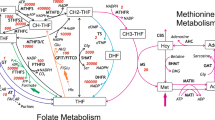Abstract
IN recent years considerable interest has been aroused in the possible role of the rate of synthesis and the concentration and oxidation state of NADP as regulatory factors in metabolism. In view of the well-known fact that tumours have a low level of NADP, and especially of NADPH21–3, it seemed of importance to measure the rate of synthesis of NADP and its oxidation-reduction state in both the precancerous phase and in fully developed hepatomas, as a preliminary step in elucidating the role of this compound in tumour metabolism. Although the rate of synthesis of NAD has been measured in some tumours (see Morton4) there is a paucity of data on the rates of synthesis of NADP (see Reid5). To this end we have measured the concentration of NADP in the livers of rats after relatively short periods of feeding with carcinogens (between 14 and 30 days with either 4-dimethylamino-3′-methylazobenzene (3′ MeDAB) or 4-dimethylamino-4′-fluoroazobenzeno (4′ F DAB)) as well as in the hepatomas developed after long periods of treatment with azo-dyes. In addition we have measured the acid-labile NADP recently described by Burch, Lowry and Von Dippe6. Although the physiological significance of this form of NADP is not entirely clear it seemed worth investigating since it was possible that this more labile, and perhaps ‘bound’ form, could be an important component in tumour tissue, particularly in view of the finding that the glucose-6-phosphate dehydrogenase activity of liver tumours is high3,7,8.
This is a preview of subscription content, access via your institution
Access options
Subscribe to this journal
Receive 51 print issues and online access
$199.00 per year
only $3.90 per issue
Buy this article
- Purchase on Springer Link
- Instant access to full article PDF
Prices may be subject to local taxes which are calculated during checkout
Similar content being viewed by others
References
Glock, G. E., and McLean, P., Biochem. J., 65, 413 (1957).
Wintzerith, M., Klein, N., Mandel, L., and Mandel, P., Nature, 191, 467 (1961).
Nodes, J. T., and Reid, E., Brit. J. Cancer (in the press).
Morton, R. K., Nature, 181, 540 (1958).
Reid, E., Cancer Res., 22, 398 (1962).
Burch, H. B., Lowry, O. H., and Von Dippe, P., J. Biol. Chem., 238, 2838 (1963).
Weber, G., Adv. Cancer Res., 6, 403 (1961).
Morris, H. P., Prog. Exp. Tumour Res., 3, 370 (1963).
Emmelot, P., and Brombacher, P. J., Biochim. Biophys. Acta, 22, 487 (1956).
Dickens, F., in Enzymes: Conf. Enzymes and their Action, Wageningen, 105 (N.V. Uitgevers-Maatschappij W.E.J. Tjeenk Willink-Zwolle, Netherlands, 1959).
Slater, T. F., and Sawyer, B., Nature, 193, 454 (1962).
Wang, T. P., and Kaplan, N. O., J. Biol. Chem., 206, 311 (1954).
Author information
Authors and Affiliations
Rights and permissions
About this article
Cite this article
CLARK, J., GREENBAUM, A., MCLEAN, P. et al. Concentrations and Rates of Synthesis of Nicotinamide-adenine-dinucleotide Phosphate in Precancerous Livers and Hepatomas induced by Azo-dye Feeding. Nature 201, 1131–1132 (1964). https://doi.org/10.1038/2011131a0
Issue Date:
DOI: https://doi.org/10.1038/2011131a0
This article is cited by
-
Metabolitanalysen bei schnell wachsenden DS-Carcinosarkomen der H�hner-Chorioallantois
Zeitschrift f�r Krebsforschung (1969)
-
Enzymmuster benigner und maligner Veränderungen menschlicher Gewebe
Klinische Wochenschrift (1966)
Comments
By submitting a comment you agree to abide by our Terms and Community Guidelines. If you find something abusive or that does not comply with our terms or guidelines please flag it as inappropriate.



